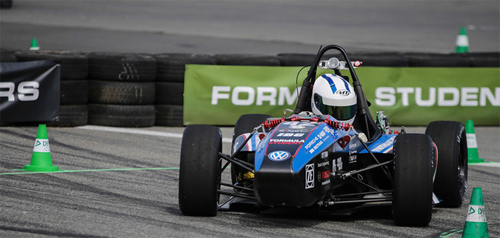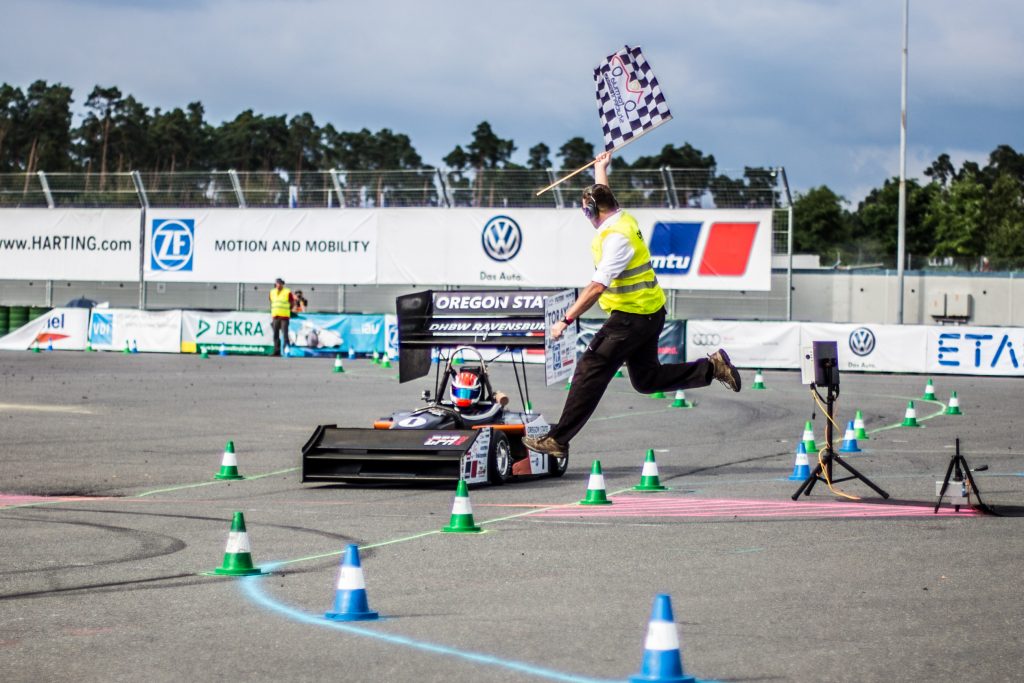Formula Student Germany – A Design Competition
This week we bring back guest blogger Joachim Schlosser, who leads a team of Education Technical Specialists from his office in Germany. That gave him a special vantage point for a thrilling student competition.
Formula Student Germany
by Joachim Schlosser
The air is shimmering at 37°C. From a cloudless sky, the sun beats down on the asphalt track. We are at an automobile race track in Hockenheim, in southwest Germany. Numerous groups of students wearing matching t-shirts crowd around the cars the pits. It is a young crowd, with students specializing in mechanical engineering, electrical engineering, mechatronics, business and finance, and computer science. Among them is Julian Vossen, a student of mechanical engineering at RWTH Aachen University. He is examining the data from the recent run of his car’s cooling system. His team, Ecurie Aix Aachen, built a car, and they came here to win. The event is Formula Student Germany.
Formula Student Germany brings together 3000 students and 115 teams from 30 nations all over the world. Modeled on a similar event in North America, it has been running since 2006. The event features two different kinds of cars: conventional combustion engines (75 teams) and purely electrical vehicles (40 teams). Over the last year these students have sacrificed evenings, weekends, and sometimes the attendance of university seminars and classes to finish their project.

What is so special about Formula Student Germany? Both Tim Hannig, the chairman of the board, and Julian highlight the special atmosphere. There is plenty of competition, but the teams are incredibly helpful to each other when something breaks and another team needs something. And all agree that it is a really good feeling to build a car from scratch. They develop a concept for the chassis and the drive train. They have to think about how many and which electric drives to use. They develop gearboxes. They evaluate different concepts for cooling. Some teams even build the car body out of composite carbon fiber materials, which requires a huge effort.
So they design and construct a real car. And therefore, they want to use the software tools that car manufacturers and their suppliers like for real car design, too. More and more teams were approaching MathWorks, and so the company now offers complimentary use of MATLAB & Simulink and more than 35 add-ons to all teams participating in Formula Student Germany.
Enter the cooling man
Back to Julian Vossen. In the team from RWTH Aachen, he is responsible for building the cooling system of the engine. The engine generates a lot of heat that has somehow to be transferred away. Otherwise it could lead to an engine meltdown. So the cooling system is important for the overall performance. The lower the temperature of the engine, the better its efficiency. The problem ultimately is to control the temperature over the course of a 22-kilometer endurance test.

Photo courtesy Formula Student Germany, Kimmo Hirvonen.
Julian modeled the whole system in Simulink and Simscape, creating a block diagram that represents the physical parts of the system like pumps, motors, heat sinks. He then fed the data about the race course that he had into the system and so could simulate the temperature load of the whole race without having built any real part of the car yet. Julian saw the different curves of temperature and used these results to dimension the radiator and other parts of the cooling system.
About MATLAB & Simulink, Julian says: “It was great to have a tool in which you can simulate transients. We can see for every second in the race temperature and other parameters.” In Simscape, the first principles add-on for physical modeling, he chooses the cooler size and pump size that exactly fit the needs of his system. The result? Their car survived the most challenging race: the endurance test, where you have to keep the car running for 22 km. They even made a pretty good lap time and ranking, which takes into account the energy consumption.
So cooling the engines is important for generating lots of torque. But how do you actually bring that torque on the pavement?
Measuring and simulating vehicle dynamics
Since 2010 the team of the University in Bayreuth competes in the Formula Student Germany Electric series. They have a pretty good electric drive pack, so the big challenge is to build a chassis that brings the enormous torque to the wheels and on the street. This highly depends on how you lay out the system and how exactly the forces act on the different poles of the wheel suspension.

Photo courtesy Formula Student Germany, S. Schindler.
So the task is to get some measurement data from the mechanics that allows calculating the individual force vectors. Elias Schmidek is student of mechanical engineering and team leader of vehicle dynamics at Elefant Racing. He applied strain gauge strips at all the 12 poles that have contact to the wheels—3 per wheel— to measure the tiny stretching that appears during the curves on the track. Each round at the test track produces tons of log files, including a trigger signal to get the time and the voltage. Furthermore, he logs the steering angle and yaw rate. All that data feeds into MATLAB, where Elias’ script calculates the forces’ absolute values for each of the connection points of the poles—the joints. Since he knows the characteristics of the materials used for the poles, he can generate the proper equations in MATLAB.

Now that he as the absolute values for all the twelve forces, it is time to calculate the force vectors. For this, Elias and his teammate Bernhard Hauffen created a model of the wheel suspensions in SimMechanics, the multi-body simulator built on the Simscape technology in Simulink. If you think of the suspension as several poles, connected by rotating joints and a prismatic joint to allow explicitly for the vertical spring damper movement, you get an accurate model of the real thing if you just design every length and position of a joint accurately. In SimMechanics, Elias feeds the absolute values for each of the joints into the simulation. The simulation now exactly puts out the three dimensional vector of all joint movements in time, and of course also the three dimensional vectors for the movement of the four wheels.
For every test on the track, the calculation of the force vectors takes just a couple of minutes, and ultimately gives insight into the forces on the wheels. With this information Elias, Bernhard and their team can construct and calibrate their chassis. And since they have all lengths of the rods as parameters in the MATLAB workspace, they can easily simulate different possibilities in their Simulink and SimMechanics model for further optimization, and eventually apply numerical optimization methods that are available in MATLAB via the Optimization Toolbox.
Why spend the effort to build such a simulation? As Elias says, having proper data on the car is the key. A drivetrain, as important as it is to be as powerful as possible, is only worth as much as you can get the power on the street. If the wheels do not have proper contact to the ground, power is lost by wheel spin. Consider the acceleration test: from a standsill the cars have to cover 75 meters as fast as possible. The best cars do this in less than four seconds, and the car from Bayreuth is among these, scoring 7th of the 40 teams.
Fascinating breadth of applications
The sheer breadth of applications of MATLAB & Simulink and the add-ons we were able to see during the week and discuss with lots of engaged members of many different teams is just amazing. What these students create in just a couple of months is the real thing.
We at MathWorks are proud to help the teams being more successful by donating a fairly large software package around MATLAB & Simulink to all teams.
The Formula Student Germany 2013 ended Sunday night with the awards ceremony for both the combustion competition as well as the electric competition. In Formula Student Combustion, Global Formula Racing (@TeamGFR) won ahead of Rennteam Stuttgart (@Rennteam0711) and Rennstall Esslingen (@Rennstall). In Formula Student Electric, DUT Racing Team scored 1st ahead of AMZ Racing from ETH Zürich (@amzracing) and ka.race.ing from KIT (@KA_RaceIng). Congratulations from MathWorks to those and to all other teams that made it to Hockenheim!









댓글
댓글을 남기려면 링크 를 클릭하여 MathWorks 계정에 로그인하거나 계정을 새로 만드십시오.